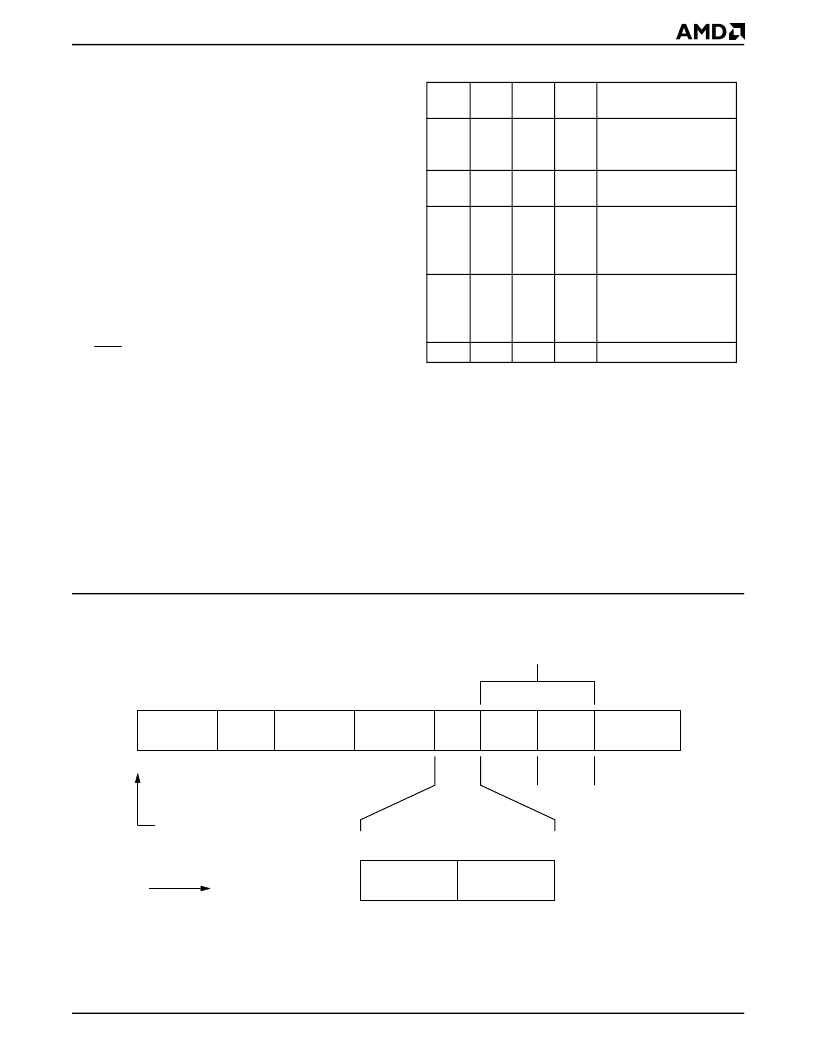- 您現(xiàn)在的位置:買賣IC網(wǎng) > PDF目錄366550 > AM79C971KCW (ADVANCED MICRO DEVICES INC) IC LOGIC 16211 24-BIT FET BUS SWITCH -40+85C TSSOP-56 35/TUBE PDF資料下載
參數(shù)資料
| 型號(hào): | AM79C971KCW |
| 廠商: | ADVANCED MICRO DEVICES INC |
| 元件分類: | 微控制器/微處理器 |
| 英文描述: | IC LOGIC 16211 24-BIT FET BUS SWITCH -40+85C TSSOP-56 35/TUBE |
| 中文描述: | 4 CHANNEL(S), 100M bps, LOCAL AREA NETWORK CONTROLLER, PQFP16 |
| 封裝: | PLASTIC, QFP-160 |
| 文件頁數(shù): | 67/265頁 |
| 文件大小: | 3190K |
| 代理商: | AM79C971KCW |
第1頁第2頁第3頁第4頁第5頁第6頁第7頁第8頁第9頁第10頁第11頁第12頁第13頁第14頁第15頁第16頁第17頁第18頁第19頁第20頁第21頁第22頁第23頁第24頁第25頁第26頁第27頁第28頁第29頁第30頁第31頁第32頁第33頁第34頁第35頁第36頁第37頁第38頁第39頁第40頁第41頁第42頁第43頁第44頁第45頁第46頁第47頁第48頁第49頁第50頁第51頁第52頁第53頁第54頁第55頁第56頁第57頁第58頁第59頁第60頁第61頁第62頁第63頁第64頁第65頁第66頁當(dāng)前第67頁第68頁第69頁第70頁第71頁第72頁第73頁第74頁第75頁第76頁第77頁第78頁第79頁第80頁第81頁第82頁第83頁第84頁第85頁第86頁第87頁第88頁第89頁第90頁第91頁第92頁第93頁第94頁第95頁第96頁第97頁第98頁第99頁第100頁第101頁第102頁第103頁第104頁第105頁第106頁第107頁第108頁第109頁第110頁第111頁第112頁第113頁第114頁第115頁第116頁第117頁第118頁第119頁第120頁第121頁第122頁第123頁第124頁第125頁第126頁第127頁第128頁第129頁第130頁第131頁第132頁第133頁第134頁第135頁第136頁第137頁第138頁第139頁第140頁第141頁第142頁第143頁第144頁第145頁第146頁第147頁第148頁第149頁第150頁第151頁第152頁第153頁第154頁第155頁第156頁第157頁第158頁第159頁第160頁第161頁第162頁第163頁第164頁第165頁第166頁第167頁第168頁第169頁第170頁第171頁第172頁第173頁第174頁第175頁第176頁第177頁第178頁第179頁第180頁第181頁第182頁第183頁第184頁第185頁第186頁第187頁第188頁第189頁第190頁第191頁第192頁第193頁第194頁第195頁第196頁第197頁第198頁第199頁第200頁第201頁第202頁第203頁第204頁第205頁第206頁第207頁第208頁第209頁第210頁第211頁第212頁第213頁第214頁第215頁第216頁第217頁第218頁第219頁第220頁第221頁第222頁第223頁第224頁第225頁第226頁第227頁第228頁第229頁第230頁第231頁第232頁第233頁第234頁第235頁第236頁第237頁第238頁第239頁第240頁第241頁第242頁第243頁第244頁第245頁第246頁第247頁第248頁第249頁第250頁第251頁第252頁第253頁第254頁第255頁第256頁第257頁第258頁第259頁第260頁第261頁第262頁第263頁第264頁第265頁

Am79C971
67
If DRCVBC (CSR15, bit 14) is cleared to 0, only BAM,
but not LAFM will be set when a Broadcast frame is re-
ceived, even if the Logical Address Filter is pro-
grammed in such a way that a Broadcast frame would
pass the hash filter. If DRCVBC is set to 1 and the Log-
ical Address Filter is programmed in such a way that a
Broadcast frame would pass the hash filter, LAFM will
be set on the reception of a Broadcast frame.
When the Am79C971 controller operates in promiscu-
ous mode and none of the three match bits is set, it is
an indication that the Am79C971 controller only ac-
cepted the frame because it was in promiscuous mode.
When the Am79C971 controller is not programmed to
be in promiscuous mode, but the EADI interface is en-
abled, then when none of the three match bits is set, it
is an indication that the Am79C971 controller only ac-
cepted the frame because it was not rejected by driving
the EAR pin LOW within 64 bytes after SFD.
See Table 6 for receive address matches.
Automatic Pad Stripping
During reception of an IEEE 802.3 frame, the pad field
can be stripped automatically. Setting ASTRP_RCV
(CSR4, bit 0) to 1 enables the automatic pad stripping
feature. The pad field will be stripped before the frame
is passed to the FIFO, thus preserving FIFO space for
additional frames. The FCS field will also be stripped,
since it is computed at the transmitting station based on
the data and pad field characters, and will be invalid for
a receive frame that has had the pad characters
stripped.
Table 6.
Receive Address Match
The number of bytes to be stripped is calculated from
the embedded length field (as defined in the ISO 8802-
3 (IEEE/ANSI 802.3) definition) contained in the frame.
The length indicates the actual number of LLC data
bytes contained in the message. Any received frame
which contains a length field less than 46 bytes will have
the pad field stripped (if ASTRP_RCV is set). Receive
frames which have a length field of 46 bytes or greater
will be passed to the host unmodified.
Figure 34 shows the byte/bit ordering of the received
length field for an IEEE 802.3-compatible frame format.
Figure 34.
IEEE 802.3 Frame And Length Field Transmission Order
PAM
LAF
M
0
BAM
DRC
VBC
X
Comment
0
0
Frame accepted due
to PROM = 1 or no
EADI reject
Physical address
match
Logical address filter
match;
frame is not of type
broadcast
Logical address filter
match;
frame can be of type
broadcast
Broadcast frame
1
0
0
X
0
1
0
0
0
1
0
1
0
0
1
0
Preamble
1010....1010
SFD
10101011
Destination
Address
Source
Address
Length
LLC
Data
Pad
FCS
4
Bytes
46
–
1500
Bytes
2
Bytes
6
Bytes
6
Bytes
8
Bits
56
Bits
Start of Frame
at Time = 0
Increasing Time
Bit
0
Bit
7
Bit
0
Bit
7
Most
Significant
Byte
Least
Significant
Byte
1
–
1500
Bytes
45
–
0
Bytes
20550D-37
相關(guān)PDF資料 |
PDF描述 |
|---|---|
| AM79C972BKCW | PCnet⑩-FAST+ Enhanced 10/100 Mbps PCI Ethernet Controller with OnNow Support |
| AM79C972BKIW | PCnet⑩-FAST+ Enhanced 10/100 Mbps PCI Ethernet Controller with OnNow Support |
| AM79C972BVCW | PCnet⑩-FAST+ Enhanced 10/100 Mbps PCI Ethernet Controller with OnNow Support |
| AM79C972 | PCnet⑩-FAST+ Enhanced 10/100 Mbps PCI Ethernet Controller with OnNow Support |
| AM79C972BVIW | PCnet⑩-FAST+ Enhanced 10/100 Mbps PCI Ethernet Controller with OnNow Support |
相關(guān)代理商/技術(shù)參數(shù) |
參數(shù)描述 |
|---|---|
| AM79C971VCW | 制造商:AMD 制造商全稱:Advanced Micro Devices 功能描述:PCnet⑩-FAST Single-Chip Full-Duplex 10/100 Mbps Ethernet Controller for PCI Local Bus |
| AM79C972 | 制造商:AMD 制造商全稱:Advanced Micro Devices 功能描述:PCnet⑩-FAST+ Enhanced 10/100 Mbps PCI Ethernet Controller with OnNow Support |
| AM79C972BKC\\W | 制造商:Advanced Micro Devices 功能描述: |
| AM79C972BKC\W | 制造商:Advanced Micro Devices 功能描述: |
| AM79C972BKCW | 制造商:AMD 制造商全稱:Advanced Micro Devices 功能描述:PCnet⑩-FAST+ Enhanced 10/100 Mbps PCI Ethernet Controller with OnNow Support |
發(fā)布緊急采購(gòu),3分鐘左右您將得到回復(fù)。